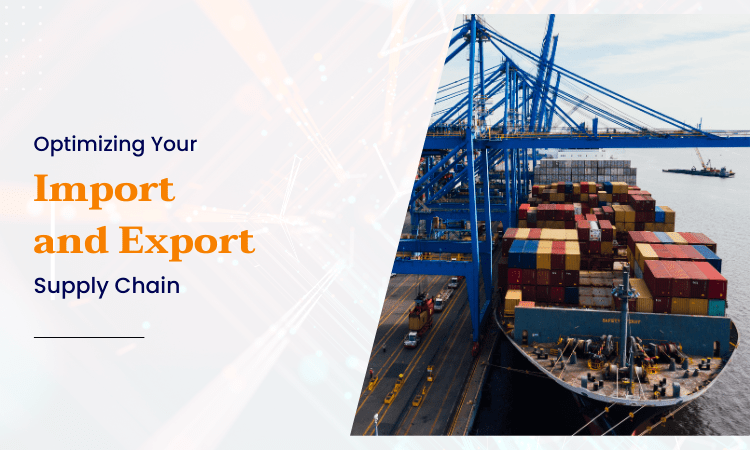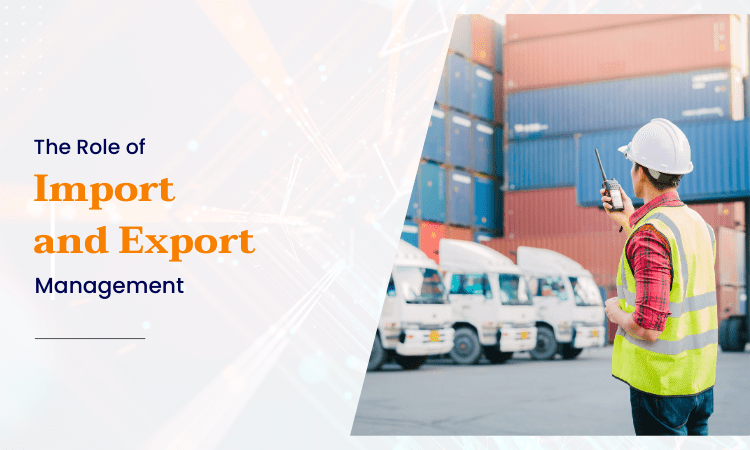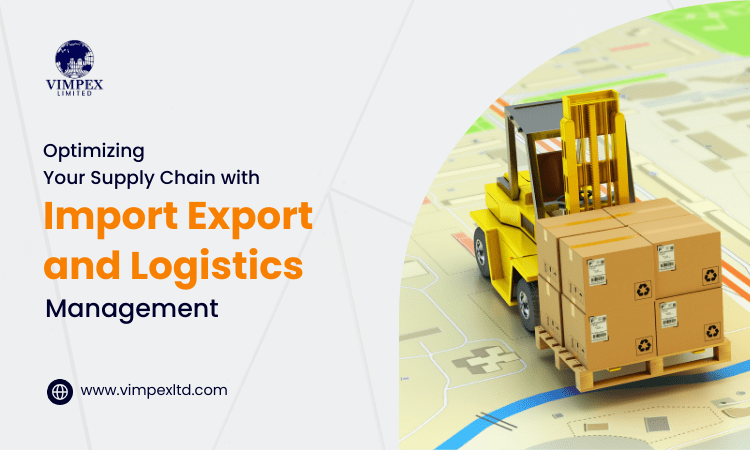Table of Contents
Introduction:
Discover the untapped potential of import and export management in streamlining your supply chain operations. With a focus on import and export logistics management, this blog post explores how these core processes can revolutionize your business, enhance efficiency, and drive bottom-line results. Discover the secrets to gaining a competitive edge in the global marketplace.
1. Mastering Import and Export Regulations: A Guide to Smooth Logistics Management:
Navigating the world of international trade can be daunting, especially when it comes to understanding and complying with import and export regulations. But fear not, intrepid logistics managers! This guide will equip you with the knowledge and resources to ensure your shipments flow smoothly across borders, saving you time, money, and frustration.
1. Know Your ABCs (Always Be Classifying):
The first step is classifying your goods accurately using harmonized system (HS) codes. These codes determine duty rates, restrictions, and licensing requirements. Consult resources like the World Customs Organization (WCO) website or seek professional help to ensure accurate classification.
2. Documentation Done Right:
From commercial invoices to certificates of origin, the paperwork involved in import and export can seem endless. Meticulously prepare all required documents according to the destination country’s regulations. Partner with a freight forwarder or customs broker to ensure accuracy and avoid delays.
3. Stay on Top of Tariffs and Duties:
Understanding the applicable tariffs and duties for your goods is crucial for cost planning and budgeting. Utilize tools like the Trade Data Web (TDW) of the United Nations or consult trade agreements for preferential rates.
4. Embrace the Power of Technology:
Numerous online resources and software solutions can simplify import and export compliance. Utilize tools for HS code classification, electronic data interchange (EDI), and cargo tracking to streamline processes and stay informed.
5. Partner with the Pros:
Don’t go it alone! Consulting experienced professionals like freight forwarders, customs brokers, and trade attorneys can provide invaluable guidance on navigating complex regulations and avoiding costly mistakes.

2. The Art of Logistics: Optimizing Your Import Export Supply Chain:
In the intricate world of international trade, where goods dance across borders and continents, logistics reigns supreme. For businesses navigating the import and export landscape, a well-oiled supply chain is not just a necessity, it’s an art form. But how do you master this art and ensure your shipments waltz through customs, not get stuck in a tango of delays and disruptions?
1. The Maestro’s Touch: Orchestrating Efficiency:
- Harmonious Planning: Conduct a symphony of meticulous planning. Analyze your import and export needs, forecasting demand and mapping out transportation routes. Consider factors like lead times, costs, and potential disruptions.
- Inventory in Tune: Maintain a balanced inventory, avoiding stockouts that disrupt deliveries and excess that burdens your cash flow. Utilize data analytics to predict demand and optimize inventory levels.
- Dancing with Deadlines: Deliver on time, every time. Clearly communicate deadlines to suppliers and partners, and implement efficient tracking systems to monitor progress and proactively address any delays.
- Customs Choreography: Navigate the intricate steps of customs clearance with precision. Ensure accurate documentation, proper labeling, and compliance with all regulations to avoid costly delays and fines. Consider partnering with a customs broker for expert guidance.
2. Beyond the Basics: Fine-Tuning Your Performance:
- Technology as Your Muse: Embrace the power of technology. Utilize logistics management software to streamline processes, track shipments in real-time, and gain valuable data insights for informed decision-making.
- Collaboration is Key: Foster strong relationships with suppliers, freight forwarders, and other partners. Open communication and collaboration can identify and address challenges proactively, leading to smoother operations.
- Agility is Your Advantage: Be prepared to adapt. The world of trade is dynamic, and unforeseen disruptions can occur. Develop contingency plans and maintain flexibility to navigate challenges and optimize your supply chain in real-time.
3. Maximizing Efficiency: How Import Export Management Drives Logistics Success:
In today’s globalized marketplace, efficiency is king. The success of your business hinges on getting your products where they need to be, when they need to be there, while minimizing costs and disruptions. The answer lies in import and export management, a strategic approach that streamlines your entire logistics operation.
1. The Engine of Efficiency:
Imagine your import and export activities as a well-oiled engine. Each component, from compliance to transportation, plays a crucial role in propelling your success. Here’s how effective import and export management optimizes each step:
- Fueling Compliance: Clear documentation, accurate HS code classification, and adherence to regulations ensure smooth customs clearance, avoiding costly delays and fines.
- Optimizing Routes and Modes: Choosing the right transportation mode (air, sea, land) and route for your needs balances speed, cost, and environmental impact.
- Inventory Harmony: Precise demand forecasting and inventory management prevent stockouts that disrupt deliveries and overstocking that strains your cash flow.
- Real-time Visibility: Utilize technology to track shipments in real-time, identify potential delays, and proactively address issues before they snowball.
- Global Collaboration: Strong partnerships with freight forwarders, customs brokers, and suppliers foster information flow and efficient problem-solving.
2. Beyond the Basics:
Going beyond the fundamentals unlocks even greater efficiency:
- Data-Driven Decisions: Leverage data analytics to identify trends, optimize routes, and make informed decisions about costs and inventory levels.
- Embracing Automation: Automate repetitive tasks like document generation and customs clearance to save time and minimize human error.
- Building Agility: Develop contingency plans to adapt to unexpected disruptions, ensuring your supply chain remains resilient.

4. From Point A to Point B: Navigating the Export Import Logistics Landscape:
The allure of international trade beckons, but the journey from your doorstep to your customer’s can be daunting. Fear not, intrepid entrepreneur! With a solid understanding of import and export logistics management, you can transform that journey into a smooth and efficient operation. Buckle up, and let’s navigate this landscape together.
1. Charting Your Course:
- Know Your Terrain: Research the import and export regulations of your target market. This includes understanding customs procedures, documentation requirements, and any applicable tariffs or quotas.
- Map Your Route: Analyze different transportation options (air, sea, land) based on cost, speed, and your product’s specific needs. Consider factors like temperature control or hazardous material regulations.
- Pack Smartly: Ensure your packaging complies with international standards and protects your goods during their journey. Labeling clearly and accurately is crucial for efficient customs clearance.
2. Embarking on Your Voyage:
- Partners in Navigation: Consider partnering with a freight forwarder who can handle the complexities of customs clearance, transportation, and documentation. Their knowledge can help you avoid headaches, wasted time, and money.
- Technology as Your Compass: Utilize logistics management software to track shipments in real-time, manage documents electronically, and gain valuable insights to optimize your operations.
- Communication is Key: Maintain open communication with your suppliers, partners, and customers throughout the journey. Timely updates and proactive problem-solving ensure smooth sailing.
3. Reaching Your Destination:
- Compliance is Key: Adherence to all regulations is paramount. Inaccurate documentation or failure to comply can lead to delays, fines, and even the seizure of your goods.
- Embrace Agility: Be prepared for unexpected disruptions, like port congestion or weather delays. Having contingency plans in place ensures you can adapt and navigate challenges efficiently.
- Continuous Learning: The world of import and export is dynamic. Stay informed about changes in regulations, trade agreements, and industry trends to maintain your competitive edge.

5. Crucial Steps for Effective Import Export and Logistics Management:
Conquering the world of international trade requires more than just great products and ambitious dreams. Efficient import, export, and logistics management are the cornerstones of success, ensuring your goods reach their destination smoothly, cost-effectively, and on time. But where do you start? Here are the crucial steps to navigate this complex landscape:
1. Planning & Preparation:
- Market Research: Deep dive into your target market’s regulations, tariffs, and customs procedures. Understanding these early on avoids costly surprises later.
- Product Classification: Classify your goods accurately using HS codes. This determines duties, restrictions, and documentation requirements. Seek professional guidance if needed.
- Documentation Mastery: Familiarize yourself with all necessary documents, like commercial invoices, certificates of origin, and packing lists. Ensure accuracy and completeness to avoid delays at customs.
2. Partnering for Success:
- Freight Forwarder: Consider partnering with a freight forwarder to handle complex logistics tasks like transportation, customs clearance, and documentation. Their expertise saves time, resources, and potential headaches.
- Customs Broker: Navigating customs can be intricate. A customs broker can guide you through the process, ensuring compliance and minimizing the risk of delays or fines.
3. Optimizing Operations:
- Transportation Strategy: Choose the right transportation mode (air, sea, land) based on cost, speed, product type, and urgency. Consider factors like temperature control or hazardous material regulations.
- Inventory Management: Strike a balance between meeting demand and avoiding overstocking. Utilize data analytics to forecast demand and optimize inventory levels, ensuring products arrive just in time.
- Technology Solutions: Embrace technology! Logistics management software streamlines tasks, tracks shipments in real-time, and provides valuable data for informed decision-making.
4. Communication & Agility:
- Open Communication: Maintain clear and transparent communication with suppliers, partners, and customers throughout the process. Timely updates and proactive problem-solving keep everyone informed and prevent issues from snowballing.
- Contingency Plans: Be prepared for disruptions like port congestion or weather delays. Develop contingency plans to adapt quickly and minimize their impact on your operations.
- Continuous Learning: The world of trade is dynamic. Stay updated on evolving regulations, trade agreements, and industry trends to maintain your competitive edge and navigate future challenges effectively.

6. Streamlining Your Supply Chain: The Role of Import and Export Management:
In today’s globalized world, businesses increasingly rely on efficient supply chains to deliver products across borders. But navigating the complexities of import and export can be a daunting task, riddled with delays, disruptions, and unexpected costs. This is where import and export management comes in, playing a crucial role in streamlining your supply chain and ensuring smooth, cost-effective operations.
1. From Chaos to Harmony:
Think of your supply chain as an intricate orchestra. Each component, from sourcing materials to delivering finished products, needs to play in perfect harmony for efficiency. Import and export management acts as the conductor, ensuring every element functions seamlessly. Here’s how:
- Clear Communication: Import and export regulations change frequently. Effective management keeps you informed, ensuring compliance and avoiding costly delays at customs.
- Strategic Sourcing: By understanding global markets and trade agreements, you can source materials more efficiently, potentially reducing costs and lead times.
- Transportation Optimization: Choosing the right transportation mode – air, sea, or land – based on cost, speed, and product type ensures timely deliveries without blowing your budget.
- Inventory Management: Balancing inventory levels across borders is crucial. Import and export management helps forecast demand and optimize inventory, preventing stockouts and overstocking.
- Risk Management: Unexpected disruptions like port congestion or political instability can throw your supply chain into disarray. Effective management helps you identify and mitigate potential risks, ensuring business continuity.
2. Technology as Your Baton:
Modern technology empowers import and export management like never before. Utilizing platforms for:
- Document management: Electronically submit documents, streamlining customs clearance and reducing errors.
- Real-time tracking: Monitor shipments in real-time, proactively address delays, and keep stakeholders informed.
- Data analytics: Gain valuable insights into your supply chain performance, optimize routes, and make informed decisions about costs and inventory.

7. Unleashing the Power of Import Export Logistics for Seamless Operations:
In the realm of international trade, the efficient management of import and export logistics is a cornerstone for businesses aiming to thrive in the global marketplace. The synergy between import and export management and logistics is paramount, acting as a catalyst for seamless operations and sustainable growth.
The key phrase, “import export and logistics management,” encapsulates the intricate dance of orchestrating the movement of goods across borders. A well-established system that integrates export import and logistics management not only ensures the timely delivery of products but also optimizes the entire supply chain, minimizing costs and enhancing overall efficiency.
Export-import logistics management involves a strategic approach to planning, executing, and controlling the movement of goods. This encompasses various stages, including transportation, customs clearance, and inventory management. By harmonizing these components, businesses can mitigate delays, reduce lead times, and enhance their competitive edge in the global market.
The key phrase, “export import and logistics management” emphasize the comprehensive nature of this integrated approach. It’s not merely about transportation but about navigating the complexities of customs regulations, documentation, and supply chain visibility. A well-orchestrated logistics management system ensures compliance with international standards, minimizing the risk of disruptions and ensuring a smooth flow of goods.
Unleashing the power of import and export logistics management goes beyond operational efficiency; it contributes to building a resilient and adaptable global trade strategy. Businesses that invest in a robust logistics framework position themselves to respond swiftly to market changes, seize new opportunities, and navigate challenges with agility. Ultimately, it is the seamless integration of import and export logistics management that empowers businesses to transcend borders and unlock the full potential of international trade.
8. Import Export Management: Strategies for Improving Supply Chain Performance:
The global marketplace beckons, but navigating the complexities of international trade can leave your supply chain feeling sluggish and inefficient. Fear not, intrepid business owner! By implementing effective import and export management strategies, you can unlock the power of seamless operations and propel your supply chain to new heights.
1. Sharpen Your Planning Blade:
- Market Mastery: Delve deep into your target markets, understanding regulations, tariffs, and customs procedures. Knowledge is power, and navigating these early on avoids costly surprises later.
- Product Classification Prowess: Classify your goods accurately using HS codes. This determines duties, restrictions, and documentation requirements. Seek professional guidance if needed, ensuring smooth customs clearance.
- Documentation Dynamo: Familiarize yourself with all necessary documents, like commercial invoices, certificates of origin, and packing lists. Accuracy and completeness are key to avoiding delays at customs.
2. Embrace Strategic Partnerships:
- Freight Forwarder Force: Consider partnering with a freight forwarder to handle complex logistics tasks like transportation, customs clearance, and documentation. Their expertise frees your time and resources, minimizing headaches.
- Customs Broker Champion: Navigating customs can be a labyrinth. A customs broker serves as your guide, ensuring compliance and minimizing the risk of delays or fines.
3. Optimize Your Operational Flow:
- Transportation Tactics: Choose the right transportation mode (air, sea, land) based on cost, speed, product type, and urgency. Consider factors like temperature control or hazardous material regulations.
- Inventory Intelligence: Strike a balance between meeting demand and avoiding overstocking. Utilize data analytics to forecast demand and optimize inventory levels, ensuring products arrive just in time.
- Technological Transformation: Embrace technology! Logistics management software streamlines tasks, tracks shipments in real-time, and provides valuable data for informed decision-making.
4. Communication & Agility: Your Secret Weapons:
- Open Communication Channels: Maintain clear and transparent communication with suppliers, partners, and customers throughout the process. Timely updates and proactive problem-solving prevent issues from snowballing.
- Contingency Plan Preparation: Be prepared for disruptions like port congestion or weather delays. Develop contingency plans to adapt quickly and minimize their impact on your operations.
- Continuous Learning: The world of trade is dynamic. Stay updated on evolving regulations, trade agreements, and industry trends to maintain your competitive edge and navigate future challenges effectively.
9. From Shipment to Delivery: Expediting Global Trade with Logistics Management:
The allure of international trade is undeniable, but let’s face it, the journey from your doorstep to your customer’s can feel like an arduous trek. Fear not, enterprising business owner! With effective logistics management, you can transform that trek into a streamlined sprint, expediting your global trade and leaving competitors in the dust.
1. Charting Your Course:
- Know Your Terrain: Research import and export regulations in your target market. Understanding customs procedures, documentation requirements, and potential tariffs is crucial to avoid delays and hiccups.
- Map Your Route: Analyze transportation options (air, sea, land) based on cost, speed, and your product’s specific needs. Consider factors like temperature control or hazardous material regulations.
- Pack Smartly: Ensure your packaging complies with international standards and protects your goods during their journey. Clear and accurate labeling is key for efficient customs clearance.
2. Embarking on Your Voyage:
- Partners in Navigation: Consider partnering with a freight forwarder who can handle the complexities of customs clearance, transportation, and documentation. Their expertise saves you time, money, and unnecessary headaches.
- Technology as Your Compass: Utilize logistics management software to track shipments in real-time, manage documents electronically, and gain valuable insights to optimize your operations.
- Communication is Key: Maintain open communication with suppliers, partners, and customers throughout the process. Timely updates and proactive problem-solving ensure smooth sailing and prevent issues from derailing your delivery.
3. Reaching Your Destination:
- Compliance is Paramount: Adherence to all regulations is critical. Inaccurate documentation or failure to comply can lead to delays, fines, and even the seizure of your goods.
- Embrace Agility: Be prepared for unexpected disruptions, like port congestion or weather delays. Having contingency plans in place ensures you can adapt quickly and minimize their impact on your delivery timeframe.
- Continuous Learning: The world of import and export is dynamic. Stay informed about changes in regulations, trade agreements, and industry trends to maintain your competitive edge and navigate future challenges efficiently.

10. Driving Growth with Export Import and Logistics Management: Best Practices for Success:
The global market beckons, offering vast potential for business growth. But navigating the complexities of import, export, and logistics can be daunting, hindering your progress. Fear not, ambitious entrepreneur! By implementing best practices in import export and logistics management, you can unlock unparalleled growth, propelling your business to international success.
1. Laying the Foundation for Success:
- Market Research Mastermind: Delve deep into your target markets, understanding regulations, tariffs, and cultural nuances. Knowledge is power, and this upfront research avoids costly surprises later.
- Product Classification Prowess: Classify your goods accurately using HS codes. This determines duties, restrictions, and documentation requirements. Seek professional guidance if needed, ensuring smooth customs clearance.
- Documentation Dynamo: Familiarize yourself with all required documents, like commercial invoices, certificates of origin, and packing lists. Accuracy and completeness are non-negotiable, preventing delays and unnecessary costs.
2. Building Agility and Efficiency:
- Strategic Partnerships: Consider partnering with a freight forwarder and customs broker. Their expertise streamlines complex tasks like transportation, customs clearance, and documentation, freeing your resources for growth.
- Transportation Tactics: Choose the right transportation mode (air, sea, land) based on cost, speed, product type, and urgency. Consider factors like temperature control or hazardous material regulations.
- Inventory Intelligence: Strike a balance between meeting demand and avoiding overstocking. Utilize data analytics to forecast demand and optimize inventory levels, ensuring products arrive just in time.
3. Technology: Your Growth Accelerator:
- Embrace Technology: Logistics management software streamlines tasks, tracks shipments in real-time, and provides valuable data for informed decision-making. This empowers you to optimize routes, costs, and inventory for maximum efficiency.
- Communication Collaboration: Utilize digital communication platforms to maintain clear and transparent communication with suppliers, partners, and customers. Timely updates and proactive collaboration prevent issues from snowballing and foster trust within your network.
4. Continuous Learning and Adaptation:
- Stay Informed: The world of trade is dynamic. Subscribe to industry updates, attend trade shows, and network with other businesses to stay informed about evolving regulations, trade agreements, and industry trends.
- Contingency Plan Preparation: Be prepared for disruptions like port congestion or political instability. Develop contingency plans to adapt quickly and minimize their impact on your operations.
- Data-Driven Decisions: Leverage data analytics to gain insights into your supply chain performance, identify areas for improvement, and make data-driven decisions for continuous optimization and growth.
Conclusion:
Optimizing your supply chain involves implementing effective import and export management strategies, as well as efficient logistics management. By streamlining your processes, improving communication, and leveraging technology, you can enhance your overall supply chain performance, reducing costs, increasing productivity, and ensuring seamless operations. With the right approach to import and export logistics management, your business can gain a competitive edge in the global market. Trust in the power of effective supply chain management to drive success.

